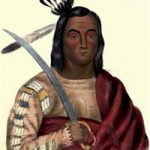
The Trembling Earth
A Sioux Chief
This portrait represents a young man of the Yankton tribe, of the Sioux nation, who, but a few years ago, occupied an obscure and menial rank. The distinction of grade seems to be a law of human nature, and occurs to some extent even in the least artificial state of society. It is observable among all the Indian tribes. The sons of chiefs and distinguished warriors stand aloof from menial employments, and are early trained to the exercises of war and hunting, while the offspring of indolent or inefficient men receive less consideration, and are apt to be thrown into degrading offices. But in either case, the individual, on arriving at maturity, becomes the artificer of his own fortune, because, in a state of existence, surrounded by danger and vicissitude, where boldness, cunning, and physical qualities are continually called into action, he must rise or sink, in the proportion that he displays the possession or the want of those qualities.
Monkaushka, or The Trembling Earth, while a boy, was employed as a cook, horse guard, &c., and had not met with any opportunity to distinguish himself, until near about the time when he arrived at manhood, when he forced himself into notice by a single act. A small party of young men of the Yankton tribe fell in with an equal number of voyageurs, who were traveling through the prairies from St. Louis to some trading establishment in the interior of the Indian country. One of the Yankton requested permission to ride on the same horse with one of the whites, which the latter declined as his horse was much fatigued, and the journey was still far from being finished. The Indian, being offended, resolved, with the capricious resentment of a savage, to take revenge upon the first opportunity, and shortly after shot an arrow through the unfortunate white man. The remainder of the party fled in alarm, and reached the Yankton camp the next day.
When the news of this outrage reached the Yankton village, Monkaushka, though a mere youth, declared himself the avenger of the white man. The Indian rule is, that the nearest relative of the deceased may put the murderer to death, but he must do it at his peril. If there be no relative who will take up the quarrel, a friend may do it; and in this instance, whatever may have been the motive of the young Indian, the act was, according to their notions, highly generous, as he took up the cause of a deceased stranger, without the prospect of reward, and at the risk of his own life He was, however, laughed at by his companions, who did not give him credit for the courage necessary to carry out such a design, and supposed that he was only indulging in an idle boast. But he was in earnest; and, having loaded his gun, he deliberately walked up to the offender, when he entered the village, and shot him dead.
The impunity with which such an act might be done, would depend much on the manner of its execution. Had not the most determined intrepidity been displayed throughout the whole proceeding, it is probable that the deed would have been prevented, or avenged. Although done under color of an acknowledged usage, it was not required by the Indian rule, and might have been considered an exception to it. The injured party was a stranger, and there was no tie of consanguinity or friendship which authorized Monkaushka to claim the office of his avenger. It might even have been an odious act to volunteer on such an occasion. It is most likely that a latent spirit that had been suppressed by the circumstances under which he had grown up, was glowing within him, and that he grasped at an opportunity, thus fortuitously presented, to emancipate himself from his humble condition. The occasion would recommend itself to a mind thus situated, by its novelty, and would make a greater impression than a common-place achievement, which required only an ordinary effort of courage. If such was the reasoning of Monkaushka, it showed a sagacity equal to his spirit; and that it was, is rendered probable by the successful event of the affair. He rose immediately to distinction, and, having since shown himself a good warrior, was, although a very young man, one of the chief persons in his tribe, and was sent to Washington, in 1837, as one of their delegates. During their stay in Washington, Monkaushka became sick. He was suffering under the influence of fever when he sat for his portrait but recovering a little, he was supposed able to proceed with the delegation on their tour to the East. On arriving at Baltimore, however, it was found impracticable for him to proceed further. He was left in charge of a faithful interpreter, and, although surrounded by all that was required for his comfort, he gradually sunk under his disease, and, after a few days of suffering, died.

